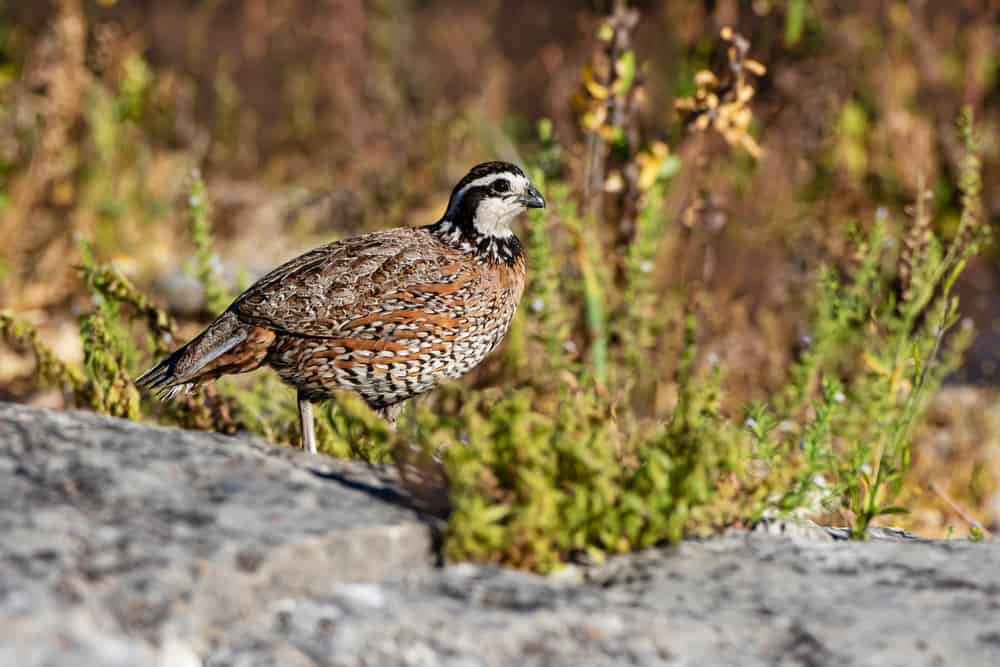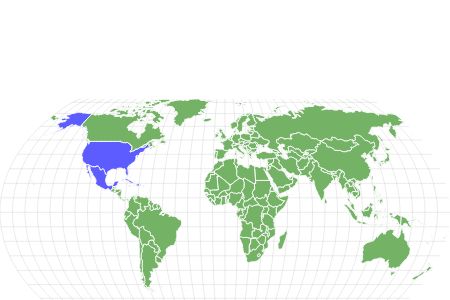Northern Bobwhite
Colinus virginianus
The northern bobwhite is named for its distinctive whistling call that sounds like ‘bob-white’.
Advertisement
Northern Bobwhite Scientific Classification
- Kingdom
- Animalia
- Phylum
- Chordata
- Class
- Aves
- Order
- Galliformes
- Family
- Odontophoridae
- Genus
- Colinus
- Scientific Name
- Colinus virginianus
Read our Complete Guide to Classification of Animals.
Northern Bobwhite Conservation Status
Northern Bobwhite Facts
- Group Behavior
- Flock
- Fun Fact
- The northern bobwhite is named for its distinctive whistling call that sounds like ‘bob-white’.
- Estimated Population Size
- 5.8 millions
- Biggest Threat
- Habitat changes
- Wingspan
- 13 to 15 inches
View all of the Northern Bobwhite images!
Northern Bobwhite Summary
“The northern bobwhite is named for its distinctive whistling call that sounds like ‘bob-white’.”
The northern bobwhite is also known as the Virginia quail or bobwhite quail. Unlike many other species of bird, the northern bobwhite does not migrate. They are found year-round throughout their native habitat in North America. There are some introduced (non-native) populations in other areas of the world as well.
Northern Bobwhite Amazing facts
- The northern bobwhite is one of the most studied bird species in the entire world.
- There are 20 different subspecies.
- They can have up to 25 offspring per year through different broods.
- Some of the fossils related to the Virginia quail are millions of years old.
Where To Find Northern Bobwhites
As a non-migratory bird species, the northern bobwhite only exists in year-round populations. They are native to the western hemisphere, specifically North America. However, because they are a common game animal and bird species, they have been introduced in other countries and continents throughout the world. Their largest population is in the United States, followed by Mexico. They are also found in Cuba and the surrounding islands.
Northern bobwhites prefer open habitats. This is one reason they prefer the American Midwest and South. They are known to live in fields, grasslands, open pastures, and open forests. Although they will avoid mature forests due to the dense vegetation, they do prefer slightly wooded areas during the winter months, especially if snow is present, as it helps maintain their access to food sources. The primary habitat for bobwhites is patchwork locations that feature several different types of open habitats in one location, such as agricultural fields neighboring grasslands and open forests.
If you’re looking for the northern bobwhite in these areas, it can be difficult to spot them. This is because their plumage and the patterns they sport are designed to help them camouflage in their natural habitats. However, you may be able to identify them by their tell-tale cry of “bob-white” or their nests.
Northern Bobwhite Nests
Northern bobwhites can fly, although rather poorly and only for a short distance. They spend the majority of their life on the ground and, as a result, will also build their nests on the ground. They may occasionally venture out to build their nests in low vegetation, but this is not as common.
Both the male and female northern bobwhite will work together to choose a nesting location. These nests, whether on the ground or in low vegetation, are typically close to an open field or even road.
Not only do both males and females work together to identify the right nesting location, but they will also work together to create the nest itself. The individuals will dig a small hole in the ground. This is usually around two inches deep and six inches wide. The inside of the nest is lined with grass. Sometimes, this species will also use grass and other types of vegetation to weave an arch to fully hide the nest. The entire nest-building process takes around 5 days.
Northern Bobwhite Scientific name
The scientific name of the northern bobwhite is Colinus virginianus. They are in the Class Aves and the Order Galliformes. The Family is Odontophoridae, which includes all species of New World quail.
There are 20 different subspecies of northern bobwhite divided into four different groups: the eastern group, Grayson’s group, the black-breasted group, and the masked group. Although there are many endangered species, such as the masked bobwhite (C. v. ridgwayi), there is only one extinct species. That is the Key West bobwhite (C. v. insulanus).
The Virginia bobtail, or C. v. virginianus, is the nominate species and the most commonly referred to.
Northern Bobwhite Size, Appearance & Behavior

The male northern bobwhite has a distinct black and white face that differentiates it from females.
Danita Delimont/Shuttershock.com©Danita Delimont/Shutterstock.com
The northern bobwhite is a small species of quail. They have rounded bodies and wings with small heads and short tails. Adults can grow to be between 9.4 and 11.0 inches in length. They can weigh 4.6 to 9.0 ounces, depending on the location and sex. Bobwhites in the south are smaller than those found further north. Their wingspans range between 13 to 15 inches.
Northern bobwhites display what is known as sexual dimorphism. This means that males and females often look different. Males tend to have more vibrant, notable colors. Both sexes have brown, white, and black markings, however. Whereas the female sports brown and black markings on the face, males more often have white and black markings.
Different subspecies will have different appearances, however. Females tend to have fewer differences between subspecies than males, which can be striking. For instance, a masked male will have an eye-catching black mask on their face rather than the Virginia subspecies’ brow stripe.
Northern Bobwhite Migration Pattern and Timing
The northern bobwhite does not migrate. They exist only in year-round populations where they can be found inside and outside the breeding season. However, there may be slight movement in individuals depending on the season.
While they will not fully migrate to a different region, northern bobwhites in the Smoky Mountains may move between high and low elevations depending on the time of year. They often winter in lower elevations and breed in higher elevations.
Northern Bobwhite Diet
Northern bobwhites are omnivorous. This means that they will eat both plant and animal matter. While they eat both, however, the majority of their diet is made up of seeds and plants. Often, they will only eat animals during the breeding season. During the breeding season, females will eat a larger percentage of animal matter than males. Chicks also eat mainly animals, typically until they reach at least six weeks of age.
These grassland game birds can also be seen eating at birdseed feeders.
Bobwhites will feed as a group. Together, they will scratch through any decaying grasses and leaves, foraging on the ground for food.
What do Northern Bobwhites eat?
The majority of their diet is made up of plant materials. This includes fruits, seeds, and the plants themselves. Some of the most common vegetation parts of their diet include:
- Agricultural crops
- Weeds
- Legume seeds
- Ragweed seeds
- Pine seeds
- Acorns
- Grass seeds.
During the summer and breeding season, bobwhites may supplement some of their diets with:
Northern Bobwhite Predators and threats
One of the largest threats to the bobwhite is loss of habitat. As human populations expand, so do cities and farmlands. This involves reducing the natural habitats in certain areas to help accommodate these human changes. Because the northern bobwhite is a year-round resident in their range, they lack the flexibility some other migratory species may boast when it comes to their habitats. This is especially true when considering the specific conditions that northern bobwhites prefer for their habitats.
Chemicals are also a significant problem for bobwhites. Because they often prefer to live in agricultural fields and areas, they are at risk of being exposed to dangerous pesticides and herbicides.
There are also natural threats, such as predators.
What eats Northern Bobwhites?
There are several predators of the northern bobwhites, both adults and their young. Some of the predators of this species include:
Northern Bobwhite Reproduction, Babies, and Lifespan
It was originally thought that the northern bobwhite was a monogamous species. However, it has been since discovered that they have several methods of mating and rearing offspring. Males may mate with multiple females and vice versa. They may also intermingle with other common species, such as ring-necked pheasants and domestic chickens, and share nests.
Bobwhites can have up to three broods. They lay between 7 and 28 eggs, each dull-white egg around 1.2 inches in length and 1 inch in width. It takes 22 to 24 days for the eggs to hatch. Hatchlings will be active and covered with down, but they still rely on their parents for warmth, food, and protection.
The oldest northern bobwhite was over six years old. Because they are common domestic animals as well as game animals, their lifespan can vary greatly.
Northern Bobwhite Population
The northern bobwhite is listed as a near-threatened species. Between 1966 and 2019, these birds faced a population decline of 81 percent. They have a global breeding population of 5.8 million. If their rate of decline from previous years continues, researchers estimate that this number could be cut in half within the next decade.
View all 65 animals that start with NNorthern Bobwhite FAQs (Frequently Asked Questions)
Do northern bobwhites migrate?
No, they do not migrate.
How many eggs do northern bobwhites lay?
Northern bobwhites can lay between 7 to 28 eggs.
What is the northern bobwhite's wingspan?
Their wingspans range between 13 to 15 inches.
When do northern bobwhites leave the nest?
They can leave the nest after one day. However, they stay with their parents for protection and support.
Thank you for reading! Have some feedback for us? Contact the AZ Animals editorial team.
Sources
- , Available here: https://www.jstor.org/stable/3782170

















